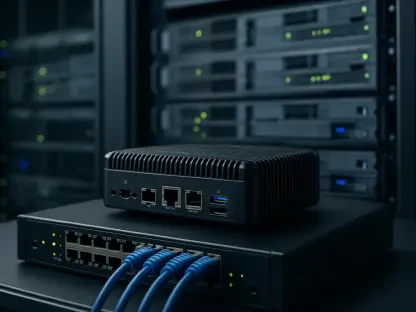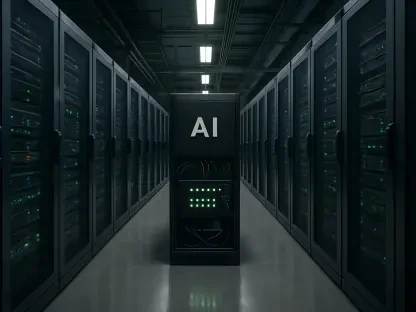In a world where artificial intelligence is reshaping industries at an unprecedented pace, Bitdeer Technologies Group, a Singapore-based company listed on NASDAQ as BTDR, has emerged as a transformative force with a remarkable 19.5% surge in its stock value as of October 4, 2025. This significant uptick is more than just a financial headline; it signals profound investor confidence in Bitdeer’s strategic evolution from a prominent cryptocurrency mining operator to a vital contributor in high-performance computing (HPC) and AI cloud services. Once primarily known for its Bitcoin mining expertise, Bitdeer has adeptly pivoted to address the insatiable demand for AI compute power, positioning itself at the forefront of technological innovation. This shift is not merely a business maneuver but a reflection of a broader industry wave where tech firms are racing to build infrastructure for AI-driven advancements. As AI continues to permeate sectors from healthcare to finance, Bitdeer’s bold moves are setting a new benchmark for what it means to power the future, sparking curiosity about how far this transformation can go in redefining the tech landscape.
Strategic Pivot to AI and HPC
From Crypto to AI: A Calculated Shift
Bitdeer’s recent stock surge of 19.5% underscores a pivotal moment in its journey, reflecting a calculated transition from Bitcoin mining to becoming a cornerstone in AI and HPC infrastructure. This shift, which began gaining traction in late 2023, represents a strategic response to the diminishing returns of cryptocurrency operations compared to the explosive growth potential in AI technologies. Investors have taken notice of this adaptability, recognizing Bitdeer’s foresight in tapping into a market driven by the urgent need for robust computing power to support complex AI models. Unlike many firms clinging to legacy operations, Bitdeer has boldly repositioned its resources and expertise, leveraging its mining infrastructure knowledge to build a foundation for AI innovation. This move aligns with a broader trend where technology companies are pivoting to meet the computational demands of generative AI and large language models (LLMs), signaling a seismic shift in industry priorities.
Beyond the financial metrics, Bitdeer’s transformation highlights a deeper understanding of market dynamics and long-term value creation, reflecting a thoughtful approach to future growth. The decision to prioritize AI over traditional crypto mining was not made in isolation but as part of a calculated strategy to capitalize on emerging opportunities. By redirecting investments toward AI-centric projects, Bitdeer has positioned itself as a leader in a space where demand for compute resources far outstrips supply. Analyst optimism, evidenced by raised price targets, further validates this direction, suggesting that the market sees Bitdeer not just as a participant but as a potential game-changer. This strategic pivot also raises questions about how other tech firms might follow suit, potentially reshaping competitive landscapes across multiple sectors as AI continues to dominate technological discourse.
Building a Sustainable Foundation
Bitdeer’s commitment to expanding its global network of data centers stands as a critical pillar of its AI strategy, with an emphasis on energy efficiency and sustainability setting it apart in an industry often criticized for its environmental impact. By establishing large-scale facilities in strategic locations across regions like North America and Asia, the company ensures proximity to key markets while optimizing for regional energy resources. A significant aspect of this expansion is the integration of green energy sources, such as hydroelectricity, into data center operations. This approach not only mitigates the massive energy consumption associated with AI workloads but also aligns with global sustainability goals, offering a model for how tech infrastructure can evolve responsibly. Such efforts demonstrate that Bitdeer is not merely chasing scale but is intent on building a future-proof foundation for AI growth.
This focus on eco-friendly infrastructure also serves as a competitive differentiator, appealing to stakeholders increasingly concerned with corporate environmental responsibility. Unlike traditional data centers that rely heavily on fossil fuels, Bitdeer’s adoption of clean energy reduces long-term operational costs while addressing public and regulatory scrutiny over AI’s carbon footprint. This balance of innovation and accountability positions the company favorably in a landscape where energy consumption remains a pressing concern. Moreover, the strategic placement of these facilities ensures low-latency access for AI enterprises, enhancing performance for time-sensitive applications. As Bitdeer continues to expand its footprint, this sustainable approach could inspire broader industry shifts, encouraging others to prioritize environmental considerations alongside technological advancements.
Technical Innovation and Partnerships
Leveraging NVIDIA’s Cutting-Edge Technology
A cornerstone of Bitdeer’s emergence in the AI space is its strategic partnership with NVIDIA, formalized in November 2023, which has significantly enhanced its technical capabilities. As a preferred NVIDIA Cloud Service Provider, Bitdeer gained access to state-of-the-art GPU technologies, including the #00 and ##00 systems, which are critical for powering intensive AI workloads. This collaboration enabled the launch of Bitdeer AI Cloud in the first quarter of 2024, offering scalable solutions tailored for generative AI and other data-intensive applications. By integrating NVIDIA’s hardware, Bitdeer ensures that its platforms can handle the computational demands of modern AI models, positioning itself as a go-to provider for enterprises seeking high-performance resources. This partnership not only validates Bitdeer’s technical ambitions but also underscores its role in bridging cutting-edge hardware with practical AI applications.
Further amplifying its impact, Bitdeer introduced an AI Training Platform in August 2024, designed to support serverless environments for developing and deploying complex AI models. This platform caters specifically to the needs of AI labs and developers, offering flexibility and efficiency that general-purpose cloud services often lack. The ability to provide such specialized tools stems directly from the NVIDIA collaboration, which equips Bitdeer with the technological edge needed to stay ahead in a rapidly evolving field. Additionally, this move highlights Bitdeer’s focus on enabling innovation at scale, ensuring that even smaller organizations can access the resources typically reserved for tech giants. The synergy between NVIDIA’s hardware expertise and Bitdeer’s infrastructure vision creates a powerful combination, poised to drive significant advancements in AI deployment across industries.
Internal Innovation Driving Competitiveness
Beyond external collaborations, Bitdeer’s internal innovations are equally pivotal in establishing its leadership in AI infrastructure. A prime example is the development of the SEALMINER A4 ASIC chip, originally engineered for Bitcoin mining but adeptly repurposed for HPC and AI applications. This proprietary technology showcases Bitdeer’s commitment to vertically integrated solutions, reducing reliance on third-party hardware and enhancing control over performance optimization. By adapting existing innovations to meet new demands, the company demonstrates remarkable agility, ensuring that its infrastructure remains at the cutting edge of AI requirements. This internal focus on research and development not only strengthens Bitdeer’s technical foundation but also sets a precedent for how legacy technology can be reimagined for emerging markets.
The significance of such in-house advancements extends to cost efficiency and customization, allowing Bitdeer to tailor solutions to specific AI workloads. Unlike competitors who may depend entirely on external hardware providers, Bitdeer’s ability to innovate internally offers a strategic advantage in a market where differentiation is key. This approach also mitigates risks associated with supply chain disruptions, a persistent challenge in the AI hardware space. Furthermore, the repurposing of technologies like the SEALMINER chip reflects a broader ethos of resourcefulness, ensuring that past investments continue to yield value in new contexts. As Bitdeer pushes forward with such initiatives, it reinforces its position as a multifaceted player, capable of both leveraging partnerships and driving independent progress in the AI ecosystem.
Competitive Positioning in the AI Ecosystem
Disrupting the Cloud Market
Bitdeer’s specialized focus on AI-centric infrastructure marks a significant departure from the broad, general-purpose services offered by hyperscale cloud providers like Amazon AWS, Microsoft Azure, and Google Cloud. By concentrating on dedicated GPU clusters and serverless environments, Bitdeer addresses critical bottlenecks faced by AI labs and startups, such as limited access to high-performance computing resources. This targeted approach enables smaller organizations to innovate without the burden of managing complex hardware, effectively democratizing access to cutting-edge technology. Unlike traditional providers that cater to a wide array of computing needs, Bitdeer’s niche strategy positions it as a disruptor, challenging established market dynamics and fostering greater competition. This shift could fundamentally alter how compute power is distributed and utilized across the tech landscape.
The competitive implications of Bitdeer’s approach are profound, as it carves out a unique space in an industry dominated by giants, focusing on the specific requirements of AI workloads. By prioritizing needs such as those for training large language models, Bitdeer offers solutions that are often more efficient and cost-effective for targeted applications. Analyst sentiment reflects this potential, with Roth Capital raising its price target from $18 to $40 alongside a “Buy” rating, citing Bitdeer’s AI and HPC focus as a key driver of value. This optimism suggests that the market sees Bitdeer not just as a competitor but as a catalyst for innovation, capable of reshaping access to essential resources. However, challenges like GPU supply constraints and the need for specialized talent remain hurdles that must be navigated to sustain this disruptive momentum.
Market Impact and Future Challenges
Bitdeer’s entry into the AI infrastructure space is already influencing market dynamics, encouraging a reevaluation of how cloud services are structured to meet modern demands. By offering tailored solutions, the company is pushing hyperscale providers to adapt or risk losing ground in the rapidly growing AI sector. This competitive pressure could lead to broader industry innovation, benefiting end-users through improved services and pricing models. Additionally, Bitdeer’s focus on enabling smaller enterprises to participate in AI development fosters a more inclusive tech ecosystem, potentially accelerating advancements across diverse fields. The ripple effects of this disruption are likely to be felt for years, as Bitdeer’s model challenges the status quo and inspires new approaches to compute resource allocation.
Yet, sustaining this impact requires overcoming significant obstacles that could temper Bitdeer’s ascent. The volatility of GPU supply chains poses a constant threat to scaling operations, as demand for high-performance hardware continues to outpace availability. Additionally, attracting and retaining top-tier AI talent is essential to maximize the potential of Bitdeer’s platforms, a task complicated by fierce competition in the tech labor market. While investor confidence remains high, as evidenced by recent stock performance, addressing these challenges will be critical to maintaining long-term growth. Bitdeer’s ability to innovate around supply constraints and build a skilled workforce will largely determine whether it can solidify its position as a lasting force in the AI cloud market.
Balancing Innovation with Responsibility
Sustainability as a Competitive Edge
Sustainability forms a vital component of Bitdeer’s strategy, distinguishing it in a field where energy consumption is a growing concern. By powering its expanding network of data centers with clean energy sources like hydroelectricity, Bitdeer tackles the environmental challenges inherent in AI’s intensive computational requirements. This commitment not only reduces the carbon footprint of its operations but also appeals to environmentally conscious stakeholders, including investors and regulatory bodies. In an era where corporate responsibility is increasingly scrutinized, Bitdeer’s green initiatives enhance its reputation as a forward-thinking entity, balancing technological progress with ecological accountability. This alignment with global sustainability goals positions the company as a model for how AI infrastructure can be developed responsibly.
Moreover, the adoption of sustainable practices offers practical benefits that bolster Bitdeer’s market standing. Utilizing renewable energy sources contributes to long-term cost efficiencies, mitigating the financial burden of powering data-intensive AI workloads. This economic advantage complements the environmental gains, creating a dual incentive for maintaining green operations. Additionally, Bitdeer’s focus on sustainability resonates with a growing segment of clients who prioritize eco-friendly partners, potentially expanding its customer base. As the tech industry grapples with the energy demands of AI, Bitdeer’s approach could set a precedent, encouraging competitors to adopt similar measures. This blend of responsibility and innovation underscores Bitdeer’s broader mission to lead not just in technology but in shaping a sustainable future for it.
Operational Benefits of Green Energy
The integration of green energy into Bitdeer’s data center operations extends beyond environmental impact to deliver tangible operational advantages. By leveraging resources like hydroelectricity, the company ensures a stable and often cheaper power supply compared to traditional fossil fuel-based energy grids, which are subject to price volatility. This stability is particularly crucial for AI infrastructure, where consistent uptime is non-negotiable for processing complex workloads. Furthermore, renewable energy sources are frequently available in regions where Bitdeer has strategically placed its facilities, optimizing both cost and performance. Such operational foresight enhances the reliability of Bitdeer’s services, making them more attractive to clients who depend on uninterrupted access to computing power.
This strategic use of clean energy also positions Bitdeer to benefit from potential regulatory incentives and public goodwill, further strengthening its competitive edge. Governments worldwide are increasingly offering subsidies and tax breaks for companies adopting sustainable practices, which could translate into additional financial savings for Bitdeer. Meanwhile, public perception of the company as an environmentally responsible player can drive partnerships and customer loyalty, especially among organizations with similar values. As AI workloads continue to scale, the energy demands will only intensify, making Bitdeer’s early adoption of green solutions a forward-thinking move. This operational strategy not only supports current growth but also prepares Bitdeer for future challenges in an energy-conscious tech landscape.
Future Prospects and Industry Influence
Shaping the Future of AI Infrastructure
Bitdeer’s journey from a cryptocurrency mining specialist to an AI infrastructure powerhouse encapsulates a narrative of bold reinvention and strategic foresight that could redefine industry standards. By focusing on HPC and AI cloud services, the company is poised to support next-generation advancements across diverse sectors, from healthcare innovations to financial modeling. Its platforms, designed to handle the rigors of training large language models and real-time simulations, offer the computational backbone necessary for transformative AI applications. This positioning not only elevates Bitdeer’s role in the tech ecosystem but also hints at a broader influence on how compute resources are accessed globally, potentially leveling the playing field for organizations of all sizes. The implications of this shift are vast, suggesting a future where AI innovation is more inclusive and widespread.
Looking ahead, Bitdeer’s ongoing data center expansions and pursuit of strategic partnerships signal a trajectory of sustained growth and impact in the technology sector. The energization of new facilities in the coming months, alongside potential collaborations with AI development partners, will likely enhance its capacity to deliver comprehensive solutions. These developments could span raw infrastructure to tailored software and APIs, catering to a wide array of organizational needs. As AI continues to permeate everyday life, Bitdeer’s infrastructure is set to become indispensable, enabling breakthroughs that were once constrained by computational limits. This forward-looking approach reflects a commitment to not just meeting current demands but anticipating future challenges, ensuring Bitdeer remains a key player in shaping the AI landscape.
Long-Term Vision and Market Transformation
Bitdeer’s long-term vision extends beyond immediate growth, aiming to fundamentally transform how the tech industry approaches AI infrastructure. By prioritizing specialized solutions over generic cloud offerings, the company challenges traditional models, encouraging a market shift toward more targeted and efficient compute resources. This transformation could inspire a wave of innovation, as competitors and new entrants alike adapt to the changing dynamics Bitdeer has introduced. The potential for smaller enterprises to leverage high-performance computing through Bitdeer’s platforms also fosters a more competitive and diverse AI ecosystem, driving progress in unexpected areas. Such a vision positions Bitdeer as a catalyst for industry-wide change, with ripple effects that could redefine technological advancement over the coming years.
Reflecting on past achievements, Bitdeer navigated significant hurdles during its pivot, from reallocating resources to mastering new technical domains, all while maintaining investor trust as evidenced by the recent stock surge. The groundwork laid through sustainable practices and strategic alliances provided a stable base for this transition. Moving forward, the focus should remain on scaling these efforts, addressing supply chain and talent challenges, and continuing to innovate in platform offerings. The tech community will be watching closely as Bitdeer rolls out new projects and partnerships in the near term, each step offering insights into the future of AI infrastructure. These next moves will be crucial in cementing Bitdeer’s legacy as a pioneer that not only adapted to change but actively shaped it.









